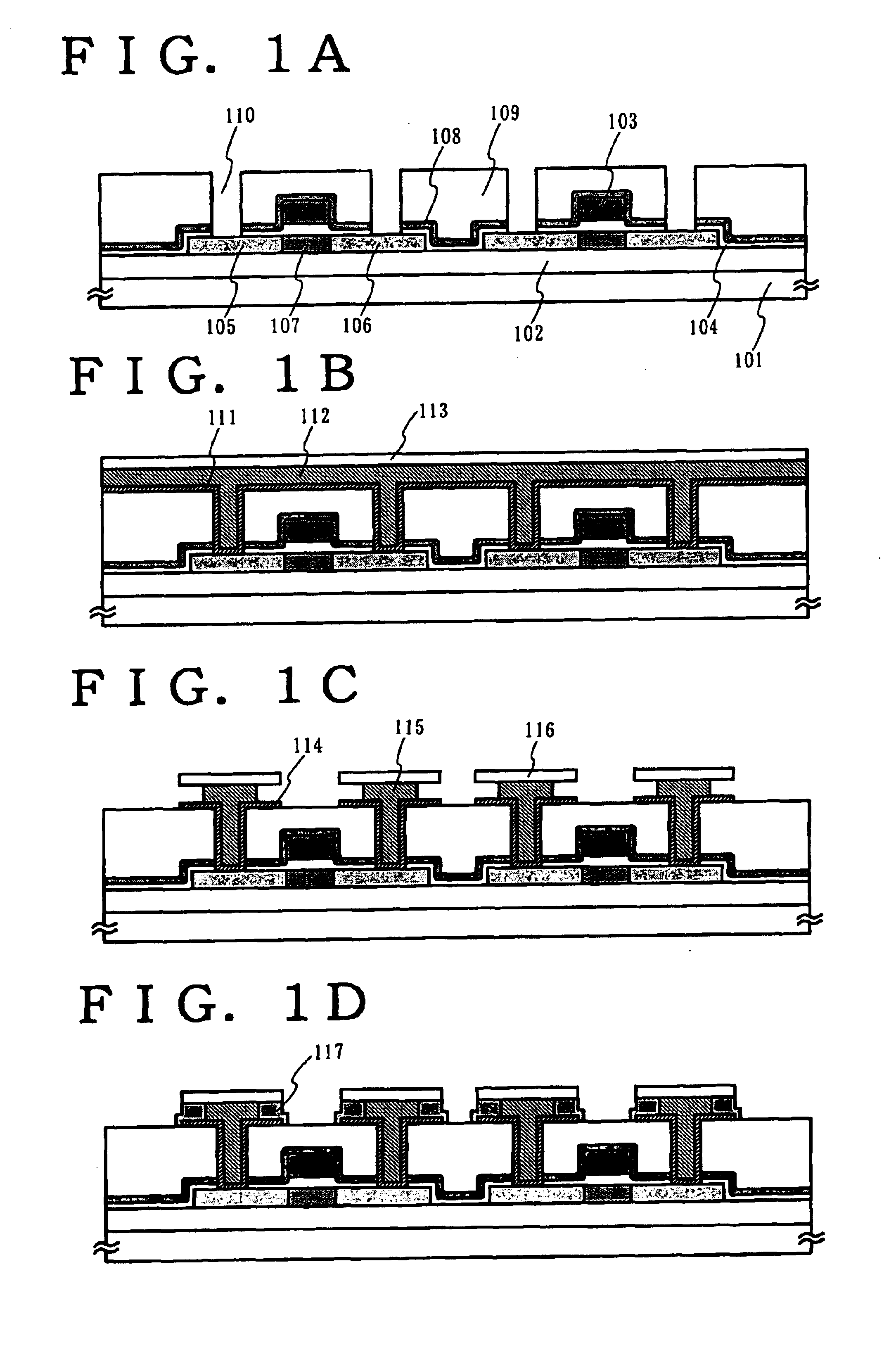Semiconductor device and method of manufacturing the same
a technology of semiconductor devices and semiconductor films, applied in semiconductor devices, semiconductor/solid-state device details, electrical equipment, etc., can solve problems such as difficulty in forming copper films, difficulty close to being solved, and apparatus problems such as shallow penetration
- Summary
- Abstract
- Description
- Claims
- Application Information
AI Technical Summary
Benefits of technology
Problems solved by technology
Method used
Image
Examples
embodiment mode 1
[0064]This embodiment mode describes, as a specific example of a semiconductor device and its manufacture method, a case of applying the present invention to wires that are connected to a source electrode and drain electrode of a TFT on a transparent insulating substrate. The description will be given with reference to FIGS. 1A to 1D.
[0065]The structural aspect of the semiconductor device is described first.
[0066]According to the basic structure used in this embodiment mode, a base film 102 is formed by deposition on a glass substrate 101 that is a transparent insulating substrate. The base film 102 is a silicon oxynitride film with a given thickness for preventing diffusion of impurity elements from the glass substrate 101. On the base film 102, a TFT is formed as a semiconductor element. The TFT is composed of a gate electrode 103, a gate insulating film 104, and a semiconductor layer. The gate electrode 103 is formed of an aluminum-based alloy or an alloy of a high-melting point ...
embodiment mode 2
[0079]This embodiment mode describes an example of applying the present invention to wires connected to a source electrode and drain electrode of a CMOS transistor on a semiconductor substrate. The description will be given with reference to FIGS. 2A to 2D. The description in this embodiment mode focuses on the structure of the CMOS transistor, and explanations on the structure and manufacture method of the wires are omitted or simplified to avoid repetition of Embodiment Mode 1.
[0080]A semiconductor element is formed on a p type silicon substrate 201 that is a semiconductor substrate. The semiconductor element is a CMOS structure transistor having an NMOS transistor and a PMOS transistor. The NMOS transistor is formed on a p type region and therefore it is not necessary to form a well structure in the p type silicon substrate 201. On the other hand, the PMOS transistor is formed on an n type region. Therefore the PMOS transistor is formed in an n well region 202 where a low concent...
embodiment mode 3
[0089]This embodiment mode is about an example of applying a wire with a low-resistant metal portion attached thereto to a gate electrode of an n-channel TFT. A specific description will be given below with reference to FIGS. 3A to 3E.
[0090]The structural aspect of a semiconductor device is described first.
[0091]In a semiconductor device of the present invention, a base film 302 is formed by deposition on a glass substrate 301 that is a transparent insulating substrate. The base film 302 is a film with a given thickness for preventing diffusion of impurity elements from the glass substrate 301, specifically a silicon oxynitride film with a thickness of 100 to 200 nm. Formed on the base film 302 is an n-channel TFT with a gate electrode having a low-resistant metal portion 315. The TFT is composed of the gate electrode, a gate insulating film 304b, and a semiconductor layer 303. The gate electrode has an electric resistance smaller than that of aluminum. The gate insulating film 304b...
PUM
| Property | Measurement | Unit |
|---|---|---|
| wavelength | aaaaa | aaaaa |
| temperature | aaaaa | aaaaa |
| temperature | aaaaa | aaaaa |
Abstract
Description
Claims
Application Information
 Login to View More
Login to View More - R&D
- Intellectual Property
- Life Sciences
- Materials
- Tech Scout
- Unparalleled Data Quality
- Higher Quality Content
- 60% Fewer Hallucinations
Browse by: Latest US Patents, China's latest patents, Technical Efficacy Thesaurus, Application Domain, Technology Topic, Popular Technical Reports.
© 2025 PatSnap. All rights reserved.Legal|Privacy policy|Modern Slavery Act Transparency Statement|Sitemap|About US| Contact US: help@patsnap.com



